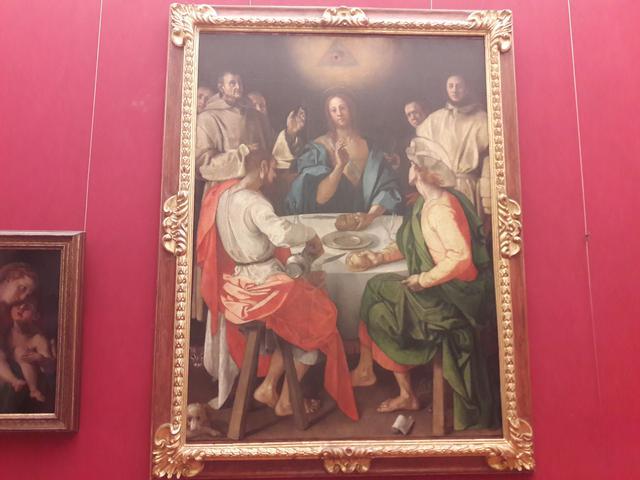Dinner at Emmaus

The Supper at Emmaus is an oil on canvas painting by Pontormo, signed and dated 1525.
The light that reveals the details of the darkness, the exasperated realism and the suspended and blocked atmosphere of the instant represented, make it an important precedent for the art of Caravaggio, Velázquez and Francisco de Zurbarán.
The work was intended for the guest house refectory or pantry of the Certosa del Galluzzo, near Florence, and so contained a theme particularly appropriate for the place where guests were received and refreshed. In fact, the painter himself took refuge there in 1523, to escape the plague, living the life of monks, silent and solitary, particularly suited to his introverted character. The work is one of the few signed and dated by the artist, on a cartouche abandoned on the ground in the foreground.
If Vasari bitterly criticized the "German manner" of the frescoes in the Certosa cloister, immediately before the canvas, he expressed great admiration for the Supper at Emmaus.
The episode comes from the Gospel of Luke, when the resurrected Christ appears to two of his disciples who initially do not recognize him and invite him to dine with them. At the table, however, in a gesture of blessing, breaking the bread and distributing it, they recognize him: "the eyes of the two disciples were opened and they recognized Jesus, but he disappeared from their sight."
The starting point for the composition derives from an engraving by Dürer in the Little Passion series (1511), which includes details such as the pose of Christ or the shape of the wide tricorne of the disciple on the right.
Pontormo represented the moment of the blessing of the bread, in a dark environment with the table loaded in the center, with a particularly high horizon, which creates an imminent effect on the viewer. Jesus stands frontally, turns towards the viewer, and the two disciples are on the sides, one in profile and the other in close profile, at the base of a hypothetical compositional pyramid. If one, Luca, tries to pour water from the jug into the glass, the other, Cleophas, on the right, stops cutting the bread with a knife and turns towards Jesus, at the moment of the revelation that begins to appear. and it seems that he is slowly beginning to understand.
The scheme, symmetrical and organized around Jesus' gesture of blessing, will be extended in the next painting. In fact, the relationship between the blessing gesture and the bread seems clear, both in the axis of the painting, making the event completely understandable.
© Tourblink